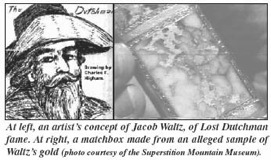May 4, 2009 © Thomas J. Kollenborn. All Rights Reserved.
The subject of Mexican mining
north of the Gila River has often conjured up tales of lost gold mines
and treasure. My father was involved in mining most of his life and
found prospecting and mineral collecting a wonderful and relaxing hobby.
My interest in mining, prospecting, lost mines and even treasure was
nurtured by my father’s interest.
Father’s best friend was an old man
named Bill Cage. Cage had worked at the Old Dominion mine in Globe, the
Magma in Superior and many other Arizona mines prior to 1930. Bill
worked for my father from 1941 until 1952. If I recall correctly Bill
Cage was born in 1869 somewhere in Indiana.
His family supposedly moved to the Salt
River Valley around 1879. Bill became a blacksmith apprentice in Phoenix
around1885. Cage worked in the Phoenix area for about ten years before
moving to Globe and working at the Old Dominion mine. During Cage’s
blacksmith apprenticeship in Phoenix he met many of the old timers and
prospectors. Bill spoke quite fluent German. My father’s German was also
quite fluent. My father and Bill became great friends even though there
was some twenty-five years difference in their ages.
Bill Cage showed up at Christmas,
Arizona looking for a job in November of 1941. Bill told Morris Watson,
the level foreman, he was looking for work. He further said he was too
old for the draft. World War II had just begun for the United States and
many young Americans were joining the military service. Morris Watson
asked Bill Cage how old he was. He told Morris he was seventy-two years
old but in good shape. My dad asked him what kind of work he did.
Cage told my father he was a blacksmith
and had worked at mines before. Finally Morris and my dad agreed to hire
Bill Cage and gave him a try. Good blacksmiths were hard to find and
the mine certainly needed help with the new demand for more copper
production because of the war.
Bill Cage was an excellent blacksmith
and could work circles around men twenty years younger then him. Bill
Cage worked for my dad until he was eighty-four years old. He was one of
the best blacksmiths ever employed at the Christmas Metal Shop.
The hiring of Bill Cage united two men
who were interested in the Superstition Mountains and the tale of the
Lost Dutchman Mine. Bill Cage could hike just about anywhere at his age.
My father soon found out he had many ideas about the location of lost
gold in the Superstition Mountains. Bill talked a lot about Mexican
mines around the Silver King and Goldfield area. Father and Cage made
only four trips into the Superstition Mountains during the war years.
The mine’s production schedule kept my father tied to his job and he had
little time to spend in the mountains.
Bill Cage and my father were both
convinced there were Mexican mines in the Superstition Mountain region.
Cage believed without a doubt that Jacob Waltz had found one of the many
rich Mexican mines in the area. Cage offered an old drift or adit in
Gold Rush Canyon as proof of Mexican mining in the area. Today Gold Rush
Canyon no longer exists. The canyon has been obliterated by open pit
mining in the area.
Bill told my dad he knew the old
“Dutchman Jacob Waltz” when he was an apprentice blacksmith in Phoenix
in the 1880’s. Bill further informed my father the “Dutchman” Waltz was a
very secretive man and talked to very few people. Bill said he repaired
a special short shovel for him, made him special chisels and made him a
small pick. He also said he worked on his pack saddles a couple of
times. Cage said Waltz often rode a dark mule and had two or three pack
burros in his string when he went into the mountains.
Dad asked Bill if he ever saw any of the
Dutchman’s gold. Bill told my father he would have to be honest about
that and said no. Bill further told my father Waltz prospected during
the winter months and worked during the summer months on irrigation
ditches for different farmers along the north bank of the Salt River. He
also said Waltz had a good size truck garden and raised a lot of
vegetables. He further said Waltz raised chickens, a few rabbits and a
couple of goats. Cage further stated Waltz claimed to have a friend in
the mountain he visited several times over the years. He never said what
mountains or what his friends name was. Cage never named Waltz’s
friend, but I would surmise it was Elisha M. Reavis.
When Bill Cage passed on in 1959, at the
ripe old age of ninety, he left behind an interesting life. He had
prospected the Superstition Mountains off and on for almost sixty years.
He left my father with a legacy about the life of an old man who loved
to search for lost gold and treasure. This lure of gold in the
Superstition Mountains had attracted a wide range of personalities who
believed strongly in the possibility of a lost gold mine or cache in the
area.
The legacy of Jacob Waltz, the old
Dutchman and the Lost Dutchman mine, continues to attract men and women
from around the nation and the world.
